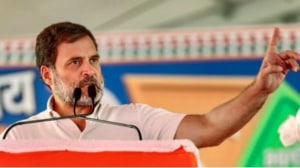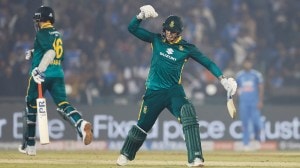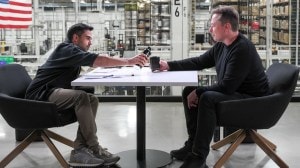Captains only toss the coin,thats all they do. I want 11 leaders on the hockey field at one time,thats what Im after
Michael Nobbs,chief coach of the Indian hockey team,was centre-half for Australia in the early eighties and was part of their 1984 Olympics team. In this Idea Exchange moderated by Special Correspondent Uthra G. Chaturvedi,Nobbs speaks about his job,the European style of the game and why he considers Indian hockey players privileged.
Uthra G. Chaturvedi: Six weeks with the team and you have won a title. How does that feel?
Its very exciting. My first coach was an Indian hockey player,he played for the Kolkata Rangers. The privileged life I have led is all because of Indian hockey and for me its like payback time. I miss homeI have two daughters and its difficult to leave them behind but sometimes in life you get a calling to do something. Ric Charlesworth (Australian hockey coach) was my roommate off and on and what I am doing in India has a lot to do with what he taught me. He called me to Western Australia and I happened to marry a Perth girl who won a hockey gold medal,her sister has a gold medal too,and her husband coached the New Zealand hockey teamso Im what you call a hockey tragic.
To coach the Indian team,most people in the world agree,is an absolute privilege,despite its difficulties. Six weeks ago,David John,who is our exercise physiologist and I landed here. From 90 players,we had to pick 48,then 30 and finally,pick a touring team. The difficult part was I couldnt spell one Indian name or pick one player from another.
When we started training,I wanted to change the style from the European style they had been playing under Jose Brasa. In Australia,we always believed it was crazy for a European to teach that style to an Indian team because they will never be able to beat them at their own game. The European style was developed to beat the Indian and Pakistan style. The Australian team is number one in the world and we learnt our hockey from India. In 1982,we started the Australian Institute of Sports,other countries progressed but India stopped.
We decided to change the style to an Indo-Australian style. At the Asian Champions Trophy (ACT),we scored 15 goals,missed every penalty corner,we didnt let too many in but you can see that the style has changed dramatically. Just four days before we left,two players walked out on us and they happened to be our penalty corner battery. So every team knew what we were going to do. We are at about 40 per cent of the level where we want to be and it will take 12 months to get there. Whether we qualify for the Olympics or not will depend on an ounce of luck more than anything else. The other teams we are competing against have years of experience. But we are a good team,no problems,no arguments during the tournament,a happy side.
Daksh Panwar: Did Ric Charlesworth tell you what kind of problems foreign coaches face here?
I was aware of the problems but most of the problems are just challenges. My job is to coach a hockey team; if you give me a bunch of boys who put India first,we can do anything.
Coomi Kapoor: In India,there is supposed to be a lot of politics in the selection of players. Did people push for their regional players and who has the final say?
I have the final say and I have no problems with people pushing their players because its their job to know their players,they have faith in their playersas long as they disclose at an appropriate time that the player they are pushing for is from their region. I am looking for players who fit in for the style that I want to pursue. And its not the federation pushing anyone. The team that I took with me was an indication of what I am looking for.
Aditya Iyer: The hockey administration and foreign coaches havent had the best of relationships. When you were about to sign on the dotted line,did you consider that it has never worked for more than a year?
It doesnt matter to me whether its six months,one or five years. And money is not a problem. India needs to go back to the top of the world,everyone recognises that. We are ranked ninth currently,lets hope it doesnt get any lower than that.
Dilip Bobb: How do you overcome the language problem? Do you use a translator for instructions?
Stick to stick,ball-to-ball,outside-right,run faster,stop,try harderthe words are the same. The object of a coach is to impart the picture of the patterns and style that he wants, to the players. Once they have that vision,they become coaches on the field and if somethings going wrong,its easy for them to fix. Thats one of the issues at the moment: half of the players are playing European style and half traditional Indian style and that means the forwards go up and never come back. The European style is that no one goes up and everyone stays back. So its interesting to melt the two styles. But language is not a problem.
Karthik Krishnaswamy: What are the cultural differences that youve noticed in the Indian,Japanese,Australian teams youve been associated with?
The Japanese players are very robotic in how they play. Culture wise,they are very reverential to senior people. In India,the hockey players are a privileged lot,they get paid,they have jobs because of hockey. Australian players dont get paid. Sometimes players start thinking they are bigger than the game because of the privileges they get from playing hockeyyou get promotions,jobs because of hockey. That power makes some people arrogant; they have to not let it get to their heads and just go out there and play hockey because of the passion.
G S Vivek: You said India won at ACT without converting a single penalty corner. Could this become a trend that teams start winning without penalty corner specialists?
Very tough. Penalty corners,and how you defend them,win and lose games. Till they change the rules,thats how it is. Thats why penalty corner batteries are important. The point of playing an attacking game is to force as many penalty corners as you can which means you have more shots at their goals and then,hopefully,if you have a good battery,you can win more games.
Coomi Kapoor: You said Indian players are privileged but the general feeling is that they are not as privileged when compared to our cricketers. What did you think of the hike in the bonuses given to them?
I dont have any problem if they are getting more money. But I think its more a jealousy thing: if the cricketers can get it,then why cant we? Crickets taken over because the Indian team has been successful; maybe we can make hockey successful and get more publicity.
Daksh Panwar: According to Charlesworth,one of the reasons Australia won the World Cup in Delhi was that they outran every other team. How fit do you think the Indian team is right now?
We are a long way off (getting) fit. David John is a nutritional expert,metabolism expert and he is working on this. Fortunately,we had a rest after every game in the ACT tournament. Had we played three straight days or a strong team like Australia,we would have probably fallen into a hole. If you see the results,we struggled every second day. Rupinder Pal is a very good example: he played 243 minutes for the first four games and the day after a rest day,he was running on petrol fumes,nothing left in the tank,so we had to replace him. And because he was so tired he couldnt flick penalty corners. All our changes are based on fitness levels and we are not fit yet.
Srinath Rao*: Are Sandeep Singh and Sardar Singh,who dropped out of the team,still part of your plans at all?
I dont know. We won a tournament without them so its hard for them to make a comeback. They walked out on the team three days before we leftwould you trust them if they came back? And what do we tell the players we replaced them with Look,were sorry,you played very well but theyve come back now so youre dropped? Its a very tough question,I dont know how to answer that right now.
Chinmay Brahme*: Both the goalkeepers alternated during the ACT. Bharat Chettri played one game,P R Sreejesh the other. Was this a strategy because most teams like to go with continuity?
I was very critical of the keepers before we left and even said publicly that they are not of international standard but it may have been,entirely,a nutritional problem. They played really well. When we measured their carbohydrate and glucose levels,they were really high which causes your hand-eye coordination reflexes to drop to up to 40 per cent and even your eyesight can suffer. Once we started to monitor them,they felt clear,sharper and their reflexes went up dramatically. I told them at the start of the tournament that no matter what the result,I was going to play them one game each at a time. Ive got faith in all my players,and everyone played.
Karthik Krishnaswamy: To be a fit team,you need a professional structure but the Australian team is amateur,so how does it work there and not work here?
Our players are professionals even if they dont get paid. They spend the same amount of time as professionals would dothey train from 6 to 9 in the morning,go to work and then train again from 4 to 7 in the evening. Add that up in a week and thats what Indians do here and they dont have to go to work.
Daksh Panwar: For sustained excellence,do we need an equivalent of the Australian Institute of Sports (AIS) in India?
Yes we do. We are trying to develop some of these centres in Delhi,Bangalore,Punjab,etc. In Australia,we have sports institutes in every state. AIS takes care of the funding and training of the teams.
Uthra G. Chaturvedi: How easy or difficult has it been to earn the respect of the players so far?
I told Rajpal Singh (the captain) before the tournament,just believe,just trust me. He came up to me at the end of the tournament and said I believe. Im an autocratic dictator,Ill let everyone have an opinion but in the end,Ill decide. Ill listen to everyoneIm just an old hockey player coaching and I may miss something. If you follow that philosophy to the end,players will follow what you do,they trust you and if you continue to get results,theyll continue to trust you.
G S Vivek: Rajpal Singh came in as captain because Arjun Halappa was injured. You have another important tournament coming up. Will you stick to him as captain?
Captains only toss the coin,thats all they do. I want 11 leaders on the field at one time,thats what Im after,not captainsthat doesnt mean anything. So hes clearly a leader; whether he will be captain or not next time,I cant say at this stage.
Aditya Iyer: You have been here for six weeks,whats your understanding of the HI-IHF mess or do you distance yourself purposely to concentrate on hockey?
Yes,I do (distance myself),completely. Its up to the politicians. All I can tell you is that the international federation,FIH,has got nothing to do with the Indian Hockey Federation (IHF). They have had bad dealings with them in the past. They recognise HI,the Indian Olympic Association recognises HI,the government recognises HI,so I dont know what will happen. It doesnt affect me or the players. We concentrate on playing,on the matches. Before the match against Pakistan at ACT,I was so scared,I was so nervous. I asked the team,Are you nervous? and they said,no,they were dying to get out there and thats what I want11 hungry guys.
Coomi Kapoor: What is the key reason for Indian hockeys dramatic decline?
Its very simple. In 1982,when we started the Australian Institute of Sports,other countries followed suit. India didnt go backwards,its just that the other countries went forward. Sports science,biomechanics,these played a huge part. The Indian team is 8-10 kg lighter than their Australian and European counterparts and thats just an indication of power and fitness ratios.
Uthra G. Chaturvedi: Why does Pakistan end up doing better despite playing the same style?
Have you ever tried to chase Shakeel Abbasi (forward) or Waseem Ahmed (centre-half)? Chasing them is not fun. As soon as they get the ball,they take it from there. Theyve got great skill. Indias got skill toowe just got to get the patterns together so that they can show those skills. What we are trying to do is to have the players Pakistan does and improve those skills. Ravi Pal said to me after the third game we won that it was the most fun he has had in international hockey all his life,and thats a great compliment to have.
*Students of Express Institute of Media Studies.
Transcribed by Smriti Sinha
- 01
- 02
- 03
- 04
- 05































